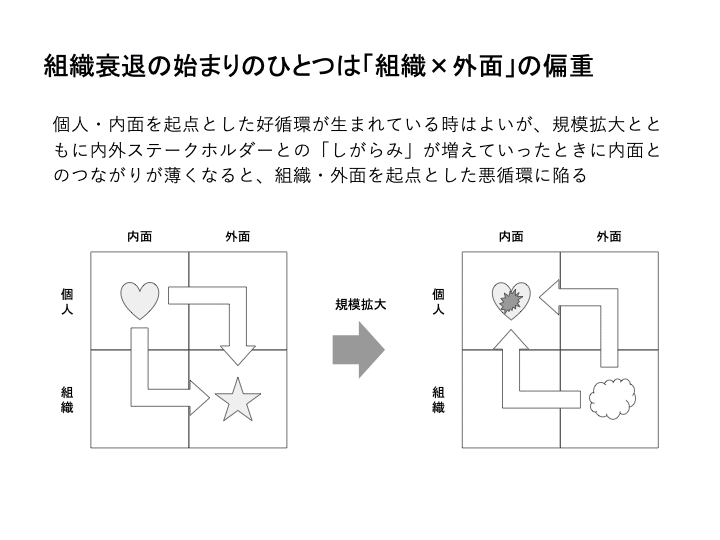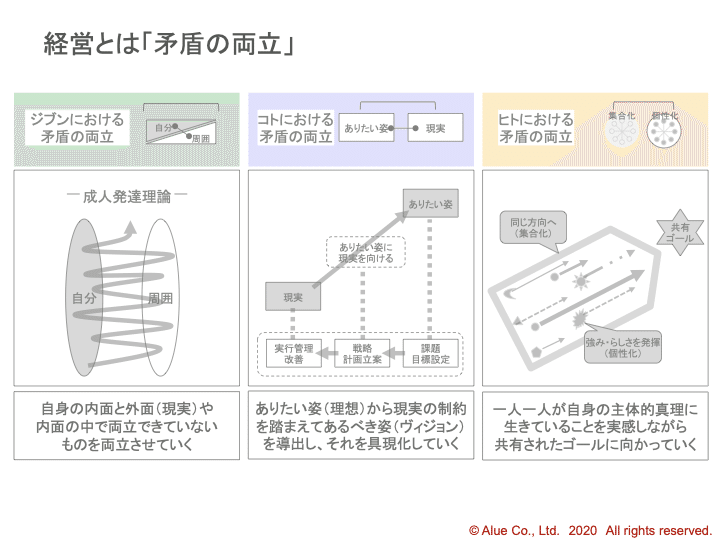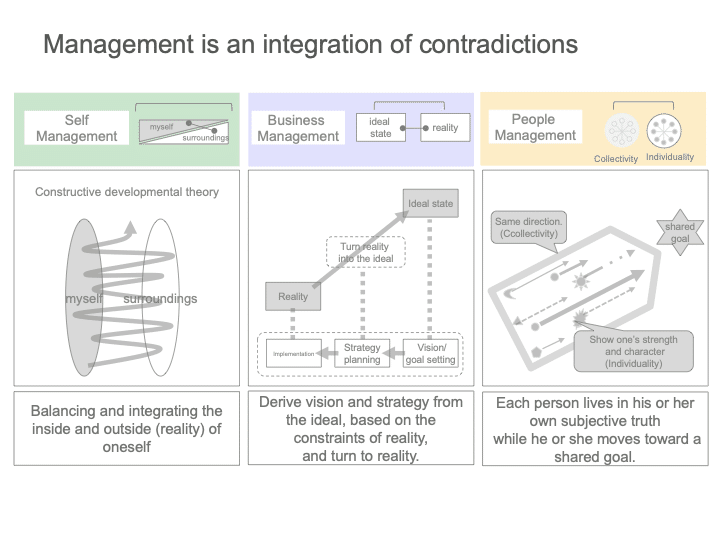
なぜ、変われることが大切なのか?
みなさんは、「最近、仕事で変化したことは何ですか?」と問われたら、どのような答えが思い浮かびますか?
さらに、「最近、仕事で変化したことの中で、自分(たち)で意図して変化したことは何ですか?」と問われたらどうしょう?
お客様への提案の仕方を変えてみたとか、上司や部下とのコミュニケーションの仕方を変えてみたなど、仕事上で最近工夫したことなどが思い浮かびますね。
この記事から始まる「改善・イノベーション」に関する章では、「自ら変わること」をテーマとして意識の意識化の観点から紐解いていきたいと考えています。
変わること・変わらないことを意図できているか?
もう少し拡張して、意図していること・意図してないこと、変化したこと・変化していないこと、の2×2のマトリックスで考えてみましょう。最近の仕事を思い返したときに、それぞれどのようなことが思い浮かびますか?
①意図して変化したこと
②意図せず変化したこと
③意図して変化してないこと
④意図せず変化していないこと
私自身のこの1年くらいの仕事を思い返した時に、浮かんできたことは以下のような感じでした。
①意図して変化したこと
・社内の業務改善・業務の清流化
・人事機能を強化して、1on1などの社内コミュニケーションを強化
・新しい商品・サービスの開発
②意図せず変化したこと
・外部環境変化によるサービスのオンライン化、ならびにリモートワーク
③意図して変化してないこと
・会社の経営理念(ミッション・ヴィジョン・バリュー)
・戦略ストーリー
④意図せず変化していないこと
・人事制度
・組織構造
・社内における代表取締役としての自分の役割
私は、これを書き出したときに、④「意図せず変化していないこと」については、思い浮かべるのが少し難しい感覚を持つと共に、いくつか思い浮かんだ時に「本当に、今のままでいいのだろうか?」という思いが脳裏をよぎりました。

①と③については自分が意図していることですし、②についても変化があったことは認識していますので、①〜③については自分の認知の内側にあります。ただ、④については意図もしておらず、変化も自覚していないことが多く、自分の認知の外側にあります。
自分の認知の外側にあるので、思い浮かべるのが少し難しい感覚をもつと共に、変化をしていないことに対して本当にそれでよいのかの確証も持ちにくいという構図になっているのだと思います。
みなさんは、どんな感覚を持たれましたか? ④「意図せずに変化していないこと」の中には、変えたほうがいいこと、改善したほうがいいことがあったりしませんか?
組織衰退の始まりのひとつは、「組織×外面」の偏重
少し別の角度から考えてみましょう。以下の図をご覧ください。これはケン・ウィルバーのインテグラル理論を元にした図です。

インテグラル理論においては、物事の捉え方には4つの側面があるとされます。この4つの側面のうち、ビジネスにおいて普段注目されるのは第4象限の「組織×外面」です。それは、「見えやすく、わかりやすい結果」だからです。
「組織×外面」に該当するものとしては、人事制度や組織構造、ビジネスモデルやサービス・商品、売上や利益などの結果などが含まれます。普段の仕事において、話題にあがるものの多くは「組織×外面」ではないでしょうか。
これらの「組織×外面」のどの要素をとっても、元を辿ると、「個人×内面」につながります。会社であれば創業者の思い、サービスや商品であれば、それを発案した人の思いやアイディア、人事制度もそのルーツには思いやコンセプトがあるはずです。

しかし、「組織×外面」に該当するものが、個人の内面や組織の内面とのつながりを失ってしまうと、形骸化してしまい、結果的に組織が衰退したり、ビジネスとしても儲かりにくくなったりします。
このあたりの詳細については、私の課題意識の一つとして以下の記事にも記載しています。
ここで注意しておくべきことは、個人や組織の内面とのつながりが失われたものは、そのまま消えてなくなるのではなく、形骸化したまま残り続けてしまうことがあるということです。人が住まなくなった建物をそのままにしておいても、消えてなくならないのと同様に、形になったものは自然になくなってくれるとは限りません。場合によっては、形骸化して残り続けることによって、悪影響を与え続けることもあります。
そのようなときは、個人や組織の内面にある願いや思いをもとに、改善していくことが大切です。いわゆる問題解決をするというレベルのものも含まれますが、個人や組織の願いや思いによっては、より大きな変革が必要なこともあるでしょうし、ゼロから新しいものを生み出すようなイノベーションレベルのものが必要になることもあるでしょう。
一方で、何でも変化させればいいというものではありません。意図して変化していくこと、あるいは、意図して変化しないことの両方が大切です。
コトの矛盾の両立の3要素
これまで、「意図して変化していくこと(変化しないこと)」の大切さについてお話ししましたが、このことが経営という視点でどのような位置付けになるかを本記事の最後にお話します。

以下の記事でお話しした通り、私は「経営とは矛盾の両立である」と捉えています。そして、経営における矛盾を3つにカテゴリ分けしており、そのうちの一つがコト領域における矛盾の両立です。
コト領域における矛盾とは、ありたい姿と現実のギャップです。ありたい姿を考えるという点についてはヴィジョンの章でお話ししました。そして、ありたい姿を実現するための計画については戦略策定の章でお話ししました。
この記事から始まる「改善・イノベーション」に関する章においては、ヴィジョンや戦略と現実とのギャップを埋めていく方法についてお話しします。ヴィジョン、戦略、改善・イノベーションの3つが、コト領域における矛盾の両立に必要な要素になっています。
次回の記事より、改善や変革やイノベーションといった「自ら変化すること」を意識の意識化の観点から紐解いていきたいと思います。
本日の問いとなります。(よろしければ、コメントにご意見ください)
・あなたの最近の仕事において「意図せず変化していないこと」があるとすれば、それはどのようなものですか?
・あなたが、今は変えることができていないけれども、変えていけると良いと思うことは何ですか?なぜ、そのように思いますか?
Why is it important to be able to change?
If I were to ask you, "What has changed in your work lately? What kind of answer comes to mind?
What would you think of if you were asked, "Of all the things that have changed in your work lately, what is the one thing that you intentionally changed?"
I'm sure you can think of something that you have recently devised at work, such as changing the way you make proposals to customers, or changing the way you communicate with your boss or subordinates.
In the chapter on "Improvement and Innovation" starting with this article, I would like to explore the theme of "changing oneself" from the perspective of consciousness(ISHIKI) management.
Are you able to intend to change and not to change?
Let's expand a bit more and think in terms of a 2 x 2 matrix of what is intended/unintended, what has changed/not changed. When you think back on your recent work, what comes to mind for each of these?
(1) Intentional change
(2) Unintentional change
(3) Intentional non-change
(4) Unintentional non-change
When I thought back on my own work over the past year or so, the things that came to mind were as follows.
(1) Intentional change
・Improvement of internal operations and streamlining of operations
・Strengthen the HR function to enhance internal communication such as 1-on-1.
・Development of new products and services
(2) Unintentional change
・Shift to online services and remote work due to changes in the external environment
(3) Intentional non-change
・Company's management philosophy (mission, vision, and values)
・Strategy Story
(4) Unintentional non-change
・HR System
・Organizational structure
・My role as a CEO in the company
When I wrote this down, I found it a little difficult to think of "(4)Unintentional non-change," and when I did think of some of them, I had the thought, "Is it really okay to stay the way I am?
As for (1) and (3), I intend to do so, and I am aware of the change in (2), so (1) to (3) are inside my cognition. However, there are many cases in which we neither intend nor are aware of the change in (4), so it is outside of our cognition.
Because it is outside of our cognition, we find it a little difficult to recall it, and at the same time, it is difficult to be sure that it is the right thing to keep it unchanged.
What kind of feeling did you have? Are there things in the "(4) unintentional non-change" that need to be changed or improved?
One of the beginnings of organizational decline is the "organization x exterior" bias
Let's think about this from a slightly different angle. Take a look at the following figure. This is a figure based on Ken Wilber's Integral Theory.

In Integral Theory, there are four aspects to the way we perceive things. Of these four aspects, the one that is usually focused on in business is the fourth quadrant, "organization x exterior". This is because it is the result that is easy to observe and understand.
The "organization x exterior" includes human resource systems, organizational structures, business models, services and products, and results such as sales and profits. In our daily work, many of the things we talk about are most likely to be "organization x exterior."
Any of these elements of "organization x exterior" can be traced back to "individual x interior". In the case of a company, the thoughts of the founder, in the case of a service or product, the thoughts and ideas of the person who invented it, and in the case of a personnel system, there must be thoughts and concepts at its roots.

However, if what falls under the category of "organization x exterior" loses its connection to the interior of the individual and the interior of the organization, it will become a skeleton, resulting in the decline of the organization and making it harder to make profits as a business.
More details about this area can be found in the following article as part of my recognition of the issues.
What is important to note here is that things that have lost their connection to the interior of individuals and organizations do not just disappear, but may continue to remain in a skeleton form. In the same way that a building that is no longer inhabited will not disappear even if we leave it as it is, a thing that has taken shape will not necessarily disappear naturally. In some cases, they may continue to have a negative impact by remaining as a skeleton.
In such a case, it is important to make improvements based on the inner wishes and thoughts of the individual or organization. This includes so-called problem-solving, but depending on the wishes and thoughts of the individual or organization, there may be times when a larger change is needed, or there may be times when innovation that creates something new from scratch is necessary.
On the other hand, it is not enough to change everything. It is important to both change with intention and not change with intention.

Three elements of the integration of contradictions in business management area
I have talked about the importance of "changing ( or not changing) with intention," and I will talk about how this is positioned from the perspective of management at the end of this article.

As I talked about in the following article, I see management as the integration of contradictions. And I divide contradictions in management into three categories, one of which is the integration of contradictions in business management area.
The contradiction in business management area is the gap between what we want to be and what we actually are. I talked about thinking about what you want to be in the chapter on vision. And the plan to realize the desired state was discussed in the chapter on strategy planning.
In the chapter on "Improvement and Innovation" that begins this article, I will discuss how to bridge the gap between vision / strategy and reality.Vision, strategy, and improvement/innovation are the three elements needed to integrate contradictions in business management area.
From the next article, I would like to explore the concept of "changing oneself" such as improvement, change and innovation from the perspective of consciousness(ISHIKI) management.
Here are the quests of the day. (If you'd like, please share your thoughts in the comments.)
・What, if anything, has been "unintentionally non-changing" in your recent work?
・What do you wish you could change that you are not currently able to change? Why do you feel so?
Bunshiro Ochiai
この記事が気に入ったらサポートをしてみませんか?
